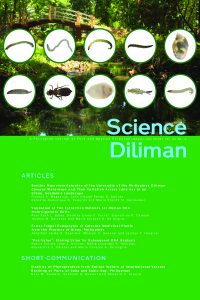 (JULY 19)— Science Diliman Volume 31, No. 1 (2019), an internationally refereed semi annual journal of pure and applied science, is now online. The latest issue has four articles and a short communication.
(JULY 19)— Science Diliman Volume 31, No. 1 (2019), an internationally refereed semi annual journal of pure and applied science, is now online. The latest issue has four articles and a short communication.
“Benthic Microinvertebrates of the University of the Philippines Diliman Campus Waterways and their Variation Across Land Use in an Urban and Academic Landscape” by Francis S. Magbanua, John Calude Renan B. Salluta, Danielle Dominique D. Deborde and Maria Brenda M. Hernandez assessed the overall condition of the waterways in UPD based on the benthic macroinvertebrate assemblages. The study revealed that all sampling sites are under poor to severe pollution conditions.
“Validation of Two Extraction Methods for Human DNA from Cigarette Butts” by Paul Ryan L. Sales, Dorothy Emma C. Ferrer, Gayvelline C. Calacal, Jazelin M. Salvador and Maria Corazon A. De Ungria, is a comparison between the organic procedure and the QIAamp® DNA Micro Kit (QIAGEN) (silica-based method) of extracting the amount and quality of DNA obtained from cigarette butts. The paper recommends the use of “organic procedure for samples collected outdoors and stored for a long period of time, while the silica-based method is recommended for samples collected indoors and stored for a short period of time. “
“Foliar Fungal Endophytes of Selected Medicinal Plants from the Province of Albay, Philippines” is a comparison of the occurrence, frequency and isolation rates of fungal endophytes (fungi living within a plant and having a symbiotic relationship to bordering on pathogenic) from the leaves of the 10 most frequently used medicinal plants in Albay across three different locations. The 120 fungal isolates from 17 species have no significant difference in terms of the number of isolates and unique species across the sampling sites. The study recommended further sampling and testing of the biological properties of the fungal endophytes. Jonathan Jaime G. Guerrero, Mhelijor A. General and Jazzlyn T. Imperial wrote the article.
The last article is “Pee Value: Storing Urine for Subsequent DNA Analysis” by Nelvie Fatima Jane A. Soliven, Maria Lourdes D. Honrado, Gayveliine C. Calacal and Maria Corazon A. De Ungria discusses the quality of urine DNA samples stored at room temperature, at 4°C and -20°C for 2 months and 9 months. Results of the study show that urine samples stored at cooler temperature provide more consistent DNA profile as compared to samples that were stored at room temperature. This finding may “serve as a decision support tool for drug investigations.”
Meanwhile, the short communication “Viability of Phytoplankton from Ballast Waters of International Vessels Berthing at Ports of Cebu and Subic Bay, Philippines” talks about the possibility of bloom-forming and potentially harmful diatom and dinoflagellate species in ballast waters from international vessels docking at the said ports. The study suggests that identified harmful phytoplankton can be transported via shipping, which may lead to bioinvasion in the local aquatic environment. The study was conducted by Nero M. Austero, Subhash S. Sawant and Rhodora V. Azanza.
Science Diliman is an awardee of the Journal Incubation Grant of the Commission on Higher Education. — Bino C. Gamba
